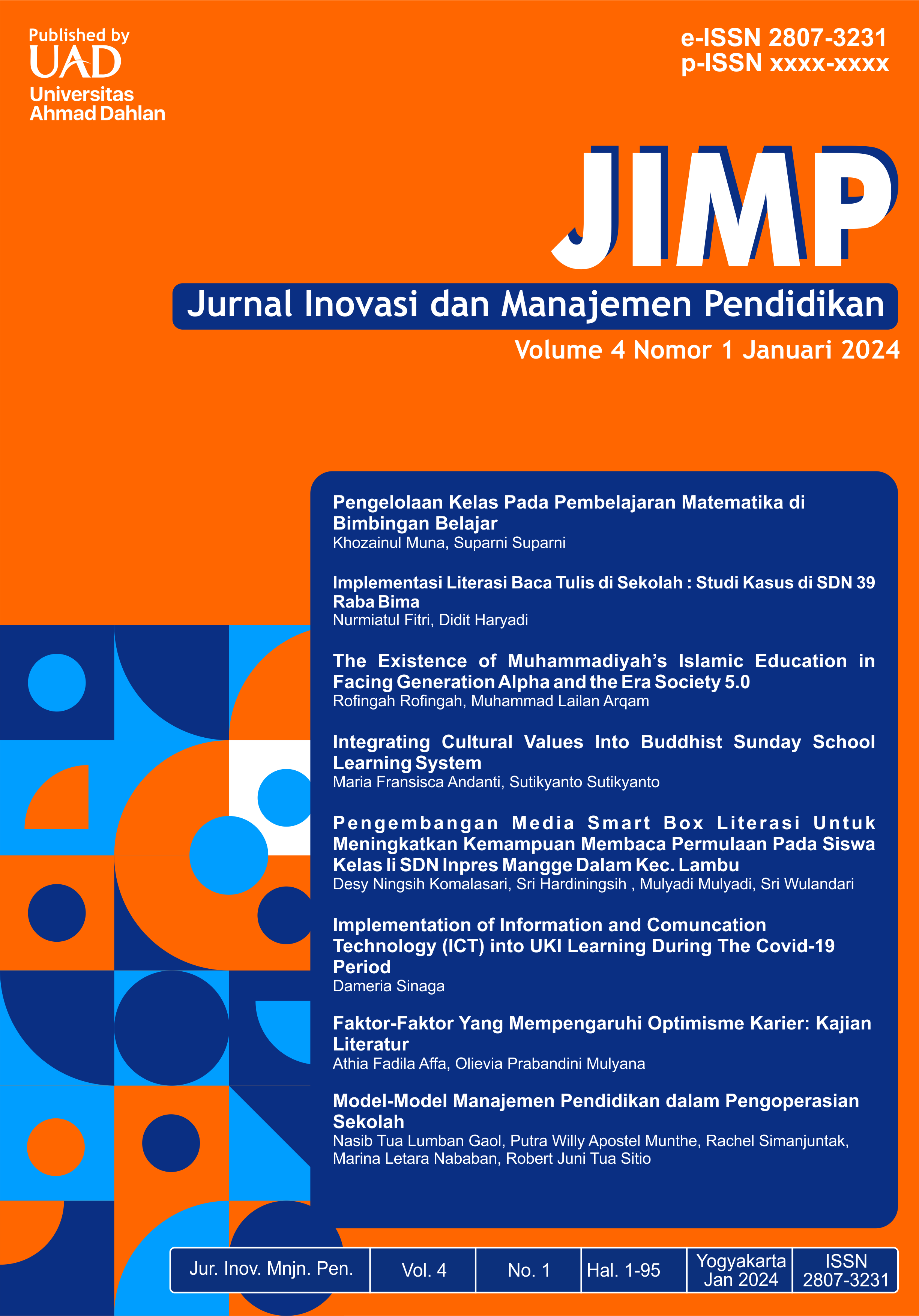Integrating Cultural Values Into Buddhist Sunday School Learning System
DOI:
https://doi.org/10.12928/jimp.v4i1.9369Keywords:
Buddhist Sunday School, Culture-based Buddhist learning system, Culture-based educationAbstract
This paper draws upon the possibility of integrating cultural values into Indonesia's Buddhist Sunday School (BSS) learning system. It employed George’s (2008) library research methods consisting of motivation or assignment, imagination, research questions (brainstorming), research plan (strategy), reference works and databases (tools and tactics), sources, evaluation, insight, thesis, argument and outline, and drafting and revising. By reviewing 25 journal articles and books regarding with culture and education, this paper proposed three things to establish cultural-based religious learning in BSS, which are strengthening cultural content and values in the learning process, building a community-based learning, and involving parents.
References
Abdulla, M.R. (2018). Culture, religion, and freedom of religion or belief. The Review of Faith and International Affairs, 16(4), 102-115. https://doi.org/10.1080/15570274.2018.1535033
Amineh, R.J., & Asl, H.D. (2015). Review of constructivism and social constructivism. Journal of Social Sciences, Literature, and Languages, 1(1), 9-16. https://pdfs.semanticscholar.org/3890/3f4a7255496f75124d639e14e9b810c17370.pdf
Bedri, Z., Fréin, R., & Dowling, G. (2017). Community-Based Learning: a primer. Irish Journal of Academic Practice, 6(1), 1-26. http://dx.doi.org/10.21427/D7F143
Caballero, J. (2015). The importance of Culture-Based Education. NABE PERSPECTIVES. https://jan.ucc.nau.edu/~jar/NABE/Caballero%20CB%20Education.pdf
Chen, D., & Yang, X. (2016). Culture as the core: Challenges and possible solutions in integrating culture into foreign language teaching. Journal of Language Teaching and Research, 7(1), 168-177. http://dx.doi.org/10.17507/jltr.0701.19
Demmert, W.G., Jr. (2009). What is culture-based education? Understanding pedagogy and curriculum. http://jan.ucc.nau.edu/~jar/HOH/HOH-1.pdf
Faith, M. (2003). Integrating cultural values into the curriculum for Kenyan schools. https://files.eric.ed.gov/fulltext/ED477141.pdf
Fakhrurrozi, M., Minabari, M., Saguni, F., & Nadirah, S. (2023). Integration of Islamic education curriculum to enhance the social character of vocational high school students. TA’DIB Journal, 26(1), 171-182. https://ojs.iainbatusangkar.ac.id/ojs/index.php/takdib/article/view/7237/3414
Government Regulation Number 55 year 2007 on Religious and Religiousity Education, Article 44 Paragraph 2
George, M.W. (2008). The elements of library research: What every student needs to know. New Jersey, NJ: Princeton University Press.
Gill, T.G. (2013). Culture, complexity, and informing: How shared beliefs can enhance our search for fitness. Informing Science: the International Journal of an Emerging Transdicipline, 16, 71-98. Retrieved from http://www.inform.nu/Articles/Vol16/ISJv16p071-098GillFT87.pdf
Hossain, K, I. (2024). Reviewing the role of culture in English language learning: Challenges and opportunities for educators. Social Societies and Humanities Open, 7(9), 1-10. https://doi.org/10.1016/j.ssaho.2023.100781
Kana’iaupuni, S. (2007). A brief overview of culture-based education and annotated bibliography. Retrieved from http://www.ksbe.edu/_assets/spi/pdfs/reports/cbe/A_Brief_Overview_of_Culture-Based_Education_v3.pdf
Kana’iaupuni, S., Ledward, B., & Jensen, ‘U. (2010). Culture-Based Education and its relationship to student outcomes. http://www.ksbe.edu/_assets/spi/pdfs/CBE_relationship_to_student_outcomes.pdf
Kia, A.D., & Sitepu, E. (2021). Culture and education. Saint Paul’s Review, 1(2), 120-130. https://jurnal.sttsaintpaul.ac.id/index.php/spr/article/view/12/9
Lebrόn, A. (2013). What is culture? Merit Research Journal of Education and Review, 1(6), 126-132. https://meritresearchjournals.org/er/content/2013/July/Lebr%F3n.pdf
Murtadlo, M. (2017). Pengembangan pendidikan agama berkearifan lokal di tanah Ulayat Baduy. EDUKASI: Jurnal Penelitian Pendidikan Agama dan Keagamaan, 15(1), 73-89. http://dx.doi.org/10.32729/edukasi.v1i1.204
Murti, R.C. (2023). Culturally responsive teaching to support meaningful learning in mathematics primary school: A content analysis in students’ textbook. Jurnal Prima Edukasia, 11(2), 294-302. http://dx.doi.org/10.21831/jpe.v11i2.63239
Nguyen, T.T.T. (2017). Integrating culture into language teaching and learning: Learner outcomes. The Reading Matrix: An International Online Journal, 17(1), 145-155. https://www.readingmatrix.com/files/16-lm7civ98.pdf
Offorma, G.E. (2016). Integrating components of culture in curriculum planning. International Journal of Curriculum and Instruction, 8(1), 1-8. https://files.eric.ed.gov/fulltext/EJ1207325.pdf
Singh, N.K. & Espinoza-Herold, M. (2014). Culture-Based Education: Lessons from indigenous education in the U.S. and Southeast Asia. NABE Journal of Research and Practice, 5(1), 7-39. http://dx.doi.org/10.1080/26390043.2014.12067773
Triyanto & Rif’ati, D.H. (2020). Prospect of integrating indigenous knowledge in the teacher learning community. Diaspora, Indigenous, and Minority Education, 14(3), 1-13. https://doi.org/10.1080/15595692.2020.1724943
Ubani, M., & Keränen-Pantsu, R. (2018). Evolving cultures of religious education: New perspective on research, policies, and practices. Journal of Beliefs and Values, 39(2), 127-131. http://dx.doi.org/10.1080/13617672.2018.1472894
Wardani, S., Haryani, S., & Anggriani, A. (2020). Analysis of teachers’ difficulties in integrating culture in primary school learning. Proceedings of the 6th International Conference on Science, Education and Technology 2020 (pp. 733-737). https://doi.org/10.2991/assehr.k.211125.139
Young, P.A. (2014). The presence of culture in learning. In J.M. Spencer, et.al (ed.), Handbook of research on educational communications and technology (pp. 349-361). New York, NY: Springer Science+Business Media.
Zuchdi, D., & Nurdi. (2019). Culture-based teaching and learning for Indonesian as a foreign language in Yogyakarta. Cakrawala Pendidikan, 38(3), 465-476. http://dx.doi.org/10.21831/cp.v38i3.26297
Downloads
Published
How to Cite
Issue
Section
License
Copyright (c) 2024 Maria Fransisca Andanti, Sutikyanto

This work is licensed under a Creative Commons Attribution-ShareAlike 4.0 International License.
This article's copyright is transferred to Universitas Ahmad Dahlan (UAD) if and when the item is accepted for publication. The undersigned hereby transfers any rights in and to the paper including without limitation all copyrights to UAD. The undersigned hereby represents and warrants that the article is original and that he/she is the author of the paper, except for material identified as to its source, with permission notices from the copyright owners where required. The undersigned represents that he/she has the power and authority to make and execute this assignment.
We declare that:
This paper has not been published in the same form elsewhere.
It will not be submitted anywhere else for publication before acceptance/rejection by this Journal.
Copyright permission is obtained for materials published elsewhere and which require this permission for reproduction.
Furthermore, I/We hereby transfer the unlimited rights of publication of the above-mentioned paper in whole to UAD. The copyright transfer covers the exclusive right to reproduce and distribute the article, including reprints, translations, photographic reproductions, microform, electronic form (offline, online), or any other reproductions of similar nature.
The corresponding author signs for and accepts responsibility for releasing this material on behalf of any co-authors. This agreement is to be signed by at least one of the authors who have obtained the co-author(s) assent where applicable. After submission of this agreement signed by the corresponding author, changes of authorship or in the order of the authors listed will not be accepted.
Retained Rights/Terms and Conditions
Authors retain all proprietary rights in any process, procedure, or article of manufacture described in the Work.
Authors may reproduce or authorize others to reproduce the Work or derivative works for the author's personal use or company use, provided that the source and the UAD copyright notice are indicated, the copies are not used in any way that implies UAD endorsement of a product or service of any employer, and the documents themselves are not offered for sale.
Although authors are permitted to re-use all or portions of the Work in other works, this does not include granting third-party requests for reprinting, republishing, or different types of re-use.







